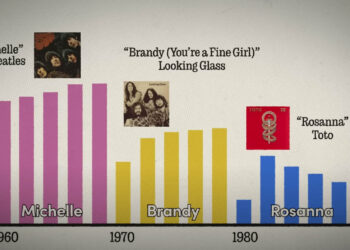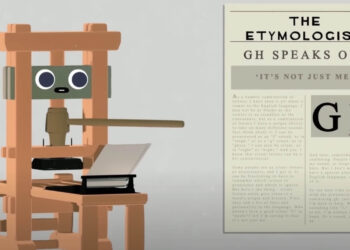I seem to recall the sequence, but there were so many pratfalls in these cartoon classics that I may be imagining it — Wile E. Coyote laying out planks or track in front of himself in a desperate attempt to survive a hare-brained scheme gone awry and bridge a fateful chasm, running out of materials, and then, after hanging implausibly in a moment of painful realization, plummeting with a whistle to become a puff of dust on the canyon’s floor.
Printers and newspaper publishers are doing an equivalent schtick, but instead of one mangy coyote hoping to buy enough time to make it to the other side, there are two, and they’re fighting.
Worse, neither can really describe the other side they’re supposedly aiming for.
This tragicomic effort was captured recently in three separate writings, two of which were related, as well as an interesting development in the world of popular fiction publishing.
The first essay, from D. Eadward Tree, analyzes how newspapers are trying to leverage the increasing amount of press downtime to take on the printing of competing papers, in addition to preparing for print jobs unrelated to the news. This bridging strategy — deploying underutilized current infrastructure to increase revenues while failing to create new strategic options — is a short-term win-win but a losing proposition long-term. That is, one newspaper gets to shut down its presses and save money by outsourcing printing to a rival, while the rival gets roughly equivalent revenues from running its presses more and staves off collapse for a time, while the factors leading to this uncomfortable accommodation remain largely unaddressed.
The macro trends leading to decreased print quantities and increased press downtime are not going away. The news business is moving online, and the pace of change is not going to slow. If anything, increases in bandwidth, device allure, and content management solutions will make newspapers seem even more of a relic than they do now. So, while the coyote thinks it’s a genius for buying time to get further out from the precipice, the forces of gravity are unrelenting.
In some cases, newspapers are purchasing equipment to allow them to print on non-newsprint stocks, an effort to create a stronger bridge made of more diverse materials. But I’m afraid that even being able to print magazines, calendars, and marketing materials suffers from the same short-term focus. In the long-run, digital will put printers in about the same position as automobiles put horse stables — remote indulgences and only useful to a few.
Like most manufacturing businesses, there’s a threshold below which continued solvency evaporates — you can’t run your presses along the full glide path from 100% to 0%; there is a moment when gravity exerts itself and you fall off the cliff. Paper manufacturers are experiencing this same phenomenon as step-functions of capacity drop them inexorably downward. At a certain depleted capacity, it makes more sense to stop completely.
The last buggy whip factory closed before the last buggy whip was made.
At the same time, underscoring how backward-looking some remain, we have the arguments from the print loyalists that print is still the defining measure of success. With magazines migrating out of print and into purely digital editions, print loyalists are stirred to speak. Samir Husni recently published a post in which he argued that if a magazine that started in print failed in print, it could have no future in digital:
Any magazine, that existed in ink on paper, and cannot survive in its original medium is DEAD. If a magazine loses its two sources of revenue, the readers and the advertisers, how on earth it is going to survive by the mere change of the platform? Do magazine publishers really think they can save money by not printing and distributing the ink on paper publication and can get the advertisers back just by transforming their publication to digital only? They better think twice.
This assertion led Bob Sacks (also known as BoSacks) to write a lengthy evisceration of Husni’s main argument:
From my perspective these words and thoughts couldn’t be more wrong. I firmly believe that ink is not one of the major components necessary for a magazine. . . . a magazine must be paginated, edited, designed, date stamped, permanent, and periodic. But it does not have to use either ink or paper to be an ‘official’ magazine. Ink and paper are an unnecessary restriction in the 21st century. . . . I can’t help pointing out that Samir delivered his article “So What is a Magazine Really?” in a digital blog and not in a printed magazine.
Sacks goes on to note that while print magazines have evolved bells and whistles like color, coated paper, fancy photography, and the like, the main item they still trade in is words — and magazines like the New Yorker are transferring very successfully to devices with no color, no bells and whistles, and the occasional cartoon. The conceit that a print magazine has to have a lot of fancy electronic trade dress to successfully migrate to digital bears re-examination, Sacks argues. Moreover, the conceit that a print magazine has to stay in print to succeed is being regularly disproved.
Meanwhile, one of the most successful self-published and e-book authors, John Locke, recently inked a publishing deal with Simon & Schuster, but it’s a deal with a twist — Locke keeps all the e-rights while Simon & Schuster takes on the print versions. Immediately, Joe Konrath predicted the end is nigh, noting that:
This is an important deal, because up until now publishers steadfastly refused to give up e-rights. But now they have. And there is no turning back. Here are some things we’ll see happening soon. Big authors will fight to keep their erights. They can make 70% on their own vs 17.5% through a publisher. They have the leverage, and will use it. If Locke, whose print sales numbers are unproven and open to speculation, can demand to keep his erights, Stephen King and James Patterson will make the same demands. They’re watching Locke, and Pottermore. If enough Big Authors follow suit, the Big 6 won’t be able to recover.
Mike Shatzkin has a less sensationalistic and more nuanced read on the situation, forgiving the likes of Simon & Schuster from inking such a deal because they face “the challenge of feeding the big organization they’ve built to deliver print to its shrinking marketplace,” while noting that by signing a distribution deal, Locke is taking advantage of a trend that print publishers may also ultimately embrace to survive:
Since all the major houses have distribution deal models, it might not be long before there’s a person at each one assigned to making sure that authors and agents are as well taken care of as “clients” as they were in the past working through their editors.
Print is diminishing — readers are moving away from it, manufacturing pressures are forcing it out, and business models more often eschew it or compartmentalize it. Print won’t ever go away entirely, and will become viewed (and is already viewed to some extent) as a luxury good, while electronic becomes the utilitarian workhorse version. In this “print is a luxury” world, the remaining presses will be asked to do more when it comes to finishes, special bindings, run varieties, color, and paper in order to create these luxury goods, while print-centric publishing houses will be asked to modify their business models to fall into orbit around the dominant e-versions. And while newspapers try to absorb more newsprint and traditional publishers compete on author service, they are in an even clearer predicament — the consolidation trend they signal will ultimately sweep them up, as well.
And each of these players is being left in the dust of a fast-moving market they seem unable to capture.
There was a rule in making the Warner Brothers Road Runner cartoons — Wile E. Coyote was to be humiliated instead of hurt. There is no such rule in business.
Discussion
10 Thoughts on "Wile E. Coyote and Print Publishing — The Tragicomedy of Desperate Measures"
These questions about the ultimate fate of print versions are also germane for scholarly publishing and in particular for the publication of scholarly journals, topics that Ithaka S+R has been covering in some of our recent surveys of US faculty members and academic librarians. I thought it might be helpful to add some of our data on these topics to the conversation.
Over the course of the past decade, the Ithaka S+R Faculty Survey has documented the steady increase in faculty members who are comfortable with their academic library ceasing to collect or maintain print versions of academic journals when digital or digitized versions are available to them. By fall 2009, the vast majority of faculty member respondents strongly agreed that “If my library cancelled the current issues of a print version of a journal but continued to make them available electronically, that would be fine with me.” These faculty respondents are from across the disciplines, with strong agreement from 60% of humanists, 77% of social scientists, and 82% of scientists.
Libraries, as we hear, are responding in kind, with significant cancellations in recent years of print versions in favor of electronic editions of scholarly journals. Bearing in mind the implications that such widespread changes might have on publishing practices, in fall 2009, we asked faculty members about their levels of agreement with this statement: “I am completely comfortable with journals that I use regularly ceasing their print versions and publishing in electronic-only form.” While roughly three-quarters of faculty members think it would no longer be necessary to collect print versions, only 39% agree strongly that they are comfortable with publishers ceasing to issue print journals.
Since these studies were released, we’ve had a lot of good discussion about the reasons that faculty members would be comfortable with print editions being cancelled by libraries but so much less so with publishers ceasing to issue them. Some interesting possibilities have included preservation concerns and authorial prestige considerations. But, for so many journals that have few individual subscriptions and are not made available to individuals as a benefit of society membership, these considerations may not be all that relevant to decision-making.
Recognizing that for, many scholarly journals, libraries are the paying customer, we used a similar question with library directors in our fall 2010 Library Survey. We asked about levels of agreement with this statement: “I am completely comfortable with journals that my library subscribes to ceasing their print versions and publishing in electronic-only form.” Of responding library directors, 70% agreed strongly that they are completely comfortable with publishers ceasing to issue print journals.
So, with print subscriptions declining and library directors largely unconcerned that print editions be issued, how are scholarly journal publishers responding? Are there steps they can take to plan strategically for, or perhaps even lead, the wind-down of their own print businesses? Are there ways that the academic library and scholarly publishing communities can work together on this area of shared interest?
References:
Matthew P. Long and Roger C. Schonfeld, Library Survey 2010: Insights From U.S. Academic Library Directors, available at http://bit.ly/dKNhX5
Roger C. Schonfeld and Ross Housewright, Faculty Survey 2009: Strategic Insights for Librarians, Publishers, and Societies, available at http://bit.ly/cFtcsB
While the trend in journal publishing from print to digital has been clear for some time now–and I don’t see any journal publishers bemoaning the change or wanting to continue their print business–the same cannot be said for books. Has Ithaka S+R done any similar surveys of faculty with regard to print vs. digital books? Interestingly, as an acquisitions editor, I have seen a trend over the past decade toward more reviewers being willing to have just an e-version of a book manuscript to review, but there is still a significant minority who want a hard copy to read; some reviewers want both.
Yes, we’ve added questions about books to our surveys in recent years.
Most faculty members tell us that ebooks are not important to them for research and teaching purposes. Whereas three-quarters of responding faculty members tell us that databases of academic journals are important to them, in 2009 13% reported that ebooks are important to them (a figure that had not grown – at all – since 2006). Notably, in 2009, prior to the release of the iPad and when tablets and reader devices had far less penetration, 31% of respondents expected ebooks to be important to them for research and teaching purposes in five years time.
Similarly, faculty members do not foresee a major print to electronic transition for books. For example, we found that few faculty member respondents agreed that “Within the next five years, the use of electronic versions of scholarly monographs will be so prevalent among faculty and students that it will not be necessary to maintain library collections of hard-copy books” – 5% of scientists, 6% of social scientists, and 1% of humanists.
The expectations of library directors on these matters are a little complex. In our 2010 survey, only 7% of library directors agreed that “Within the next five years, the use of electronic versions of scholarly monographs will be so prevalent among faculty and students that it will not be necessary to maintain library collections of hard-copy books” – not really distinguishable from the small share of faculty members who agreed with the same question. As you can imagine, both for faculty members and library directors, this is really a baseline question we introduced to allow us to measure any changes going forward.
At the same time, on average, library directors expect to shift spending on books significantly from print to electronic format over the coming 5 years. While respondents expect to spend nearly 90% of their journals budgets on e-journals, they also expect to spend a remarkable 46% of their books budgets on e-books. Put another way, they expect to spend 31% less of print books in 5 years for now. On the bright side for book publishers, they do not expect to further erode the share of their materials budgets going to books.
All these figures indicate a substantial shift ahead for scholarly monographs, beginning with current acquisitions rather than (in the case of journals) beginning with backfile materials. Whether this shift will be the same “complete” print to electronic transition that we are seeing for journals remains to be seen. It is also possible that we will enter a longer (perhaps endless) dual-format period for monographs. I’m very interested in everyone’s views on this matter.
Very interesting data. They seem to indicate that scholars are not much exercised about the growing digital divide between book and journal content. One would think that, on intellectual grounds, they would want to have the content in both formats linked to each other to facilitate search. Fortunately, Project Muse will be enabling such cross-content searching between books and journals.
This may sound like a technical point, but John Locke did not sign a publishing deal with Simon & Schuster; he signed a distribution deal. This means that all the capital deployed for Locke’s print business must be provided by him. S&S has no risk in this game. They get to utilize otherwise underutilized infrastructure, collect some cash, and put their real attention elsewhere. And that real attention has gone into leading a joint venture called Bookish, which is an online book community. I would have done this deal myself, and I have zero illusions about the long-term viability of print.
S&S has a large distribution and warehousing business.
More space should be available now that there are fewer
chain locations for S&S and their distribution and invoicing
clients to sell too. And fewer books being printed. Good
idea to bring in bestselling non-traditional publishers.
Accepting your argument that the shift from print to digital is inevitable across all types of publishing (though i would insist that it will take longer in areas where image permissions are key), we are left with the question of what role DRM will continue to play. Will more publishers cease using DRM because customers find it so annoying. adjusting their prices to reflect a certain amount of piracy as a cost of doing business this way? Is DRM more important to some sectors of publishing than others?
Simon and Schuster was the publisher that initiated the return policy that that has ill served publishers ever since. Maybe they are driving the final stake?




